Flowers have a remarkable ability to convey emotions, from love and happiness to sorrow and sympathy. They are nature’s messengers, expressing sentiments that words sometimes fail to capture. Among the vast array of floral species, there are some that stand out as symbols of joy, happiness, and love. In this bouquet of botanical symbolism, I’ll introduce you to 30 beautiful flowers, each with its unique way of radiating positivity and affection. Just like the diverse colors of a garden, these blooms paint a vibrant picture of the emotions we cherish. So, let’s embark on this fragrant journey together.
1. Cassia Fistula (Golden Shower)
Cassia Fistula, commonly known as the Golden Shower, is a tree that boasts magnificent clusters of bright yellow flowers. Native to South Asia, it is the national flower of Thailand and holds a special place in Hindu culture. The Golden Shower is not just a beautiful flower; it symbolizes happiness, prosperity, and the rejuvenation of life.
Appearance and Characteristics: The Golden Shower is renowned for its long, pendulous clusters of vibrant yellow blossoms. Its elegant petals form a cascading curtain of gold, evoking feelings of warmth and joy. The tree itself can reach towering heights of up to 50 feet, making it a true natural wonder.
Symbolism: Most yellow flowers symbolize happiness, and the Golden Shower is no exception. Its golden color signifies wealth and prosperity, while the shower-like clusters of flowers represent a cascade of happiness and positivity. In Hindu culture, the tree is associated with Lord Rama and the festival of Vaisakhi, further emphasizing its role as a symbol of new beginnings and celebrations.
Cultural Significance: In Thailand, the Golden Shower is not only the national flower but also holds cultural and religious importance. It is often used in traditional ceremonies and festivals. The tree’s golden blossoms are a vivid reminder that the bright colors of happiness can be found even in the simplest of things.
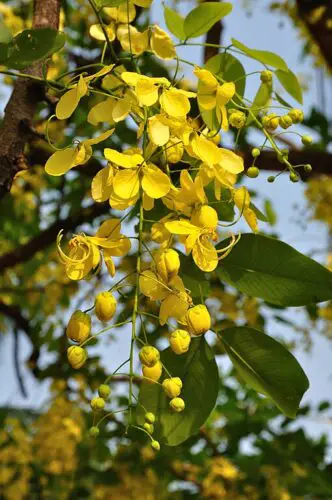
2. Alchemilla (Lady’s Mantle)
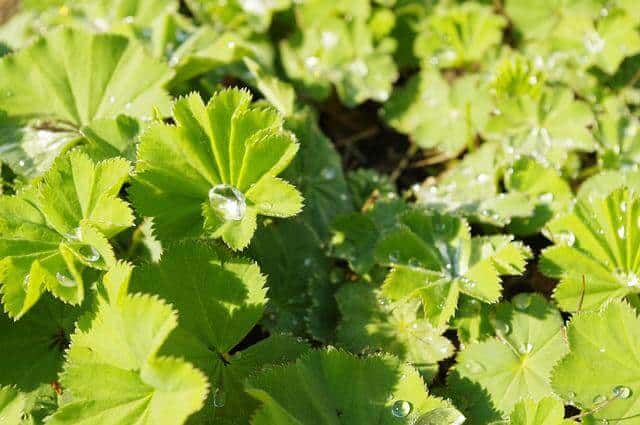
Alchemilla, or Lady’s Mantle, is a symbol of grace and elegance. Its delicate leaves and tiny greenish-yellow flowers embody the idea that beauty can be found in simplicity. Just like a genuine smile, it exudes an aura of happiness.
Appearance and Characteristics: Lady’s Mantle is a low-growing perennial herb with distinctive lobed leaves that collect dewdrops, resembling tiny jewels. Its small, greenish-yellow flowers bloom in delicate clusters, adding a touch of understated charm to any garden.
Symbolism: Alchemilla may not be as flamboyant as some other flowers, but its symbolism is no less significant. Its simplicity symbolizes happiness found in everyday moments and the beauty of life’s subtleties. It teaches us to appreciate the elegance in simplicity, just as we treasure a heartfelt, unassuming smile.
Cultural Significance: In folklore, Lady’s Mantle was believed to have magical properties, including the ability to bring happiness and protection to those who carried it. In medieval times, it was associated with the Virgin Mary, adding a layer of spiritual significance to its presence in gardens and homes.
Also Read :
Flower That Symbolizes Abandonment – Anemone(Windflower)
Top 30 Flower That Symbolizes Hope
15 Flowers That Represent Mental Health – Healing From Blooms
3. Astrantia (Masterwort)
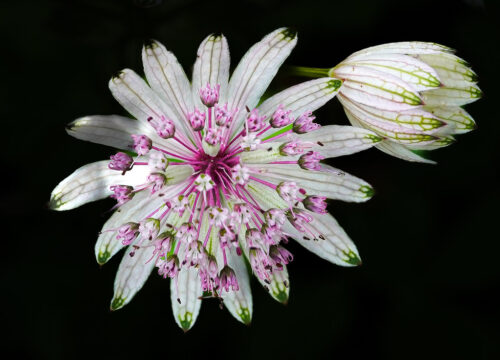
Astrantia, often referred to as Masterwort, symbolizes gratitude and appreciation. The intricate structure of its blossoms mirrors the complexity of human emotions. It’s a flower that says, “I cherish your presence in my life.”
Appearance and Characteristics: Astrantia is a perennial plant known for its unique, star-shaped flowers surrounded by papery bracts. These intricate blooms come in various shades, including white, pink, and deep red. The plant’s finely cut leaves add to its overall appeal.
Symbolism: Astrantia symbolizes appreciation and gratitude, making it an ideal choice for expressing feelings of happiness and love. Its complex structure reminds us that relationships and emotions are multi-dimensional, and it encourages us to cherish the diverse aspects of those we care about.
Cultural Significance: While not as well-known as some other flowers, Astrantia has been gaining popularity in floral arrangements and gardens for its symbolic value. It’s often used in bouquets given to friends, family, and loved ones to convey heartfelt gratitude and love.
4. Amaryllis (Hippeastrum)
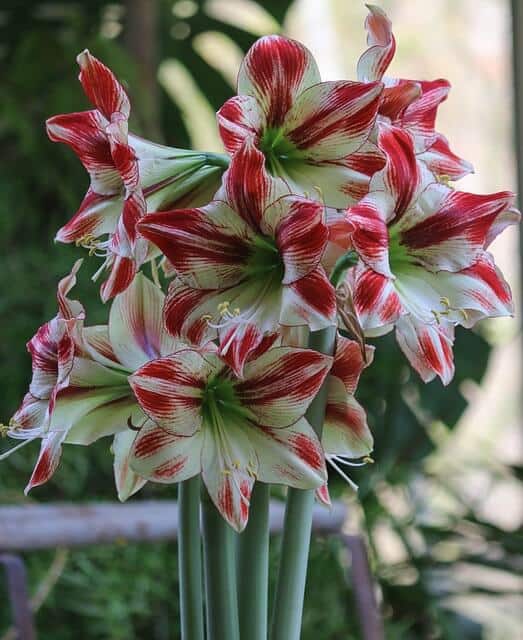
Amaryllis, also known as Hippeastrum, is a striking flower that symbolizes love and happiness. Its bold and vibrant blooms capture the essence of passion and joy, making it a wonderful gift for expressing deep emotions.
Appearance and Characteristics: Amaryllis blooms are large, trumpet-shaped flowers that come in various colors, including red, white, pink, and orange. The plant’s tall, sturdy stems add to its dramatic presence, and it often graces homes during the holiday season.
Symbolism: Amaryllis symbolizes love and happiness, especially in the context of romantic relationships. Its bold and captivating appearance reflects the intensity of passionate love and the joy it brings. Giving an Amaryllis bouquet is like sending a message of affection that cannot be ignored.
Cultural Significance: In Greek mythology, Amaryllis was a shepherdess who fell in love with a handsome shepherd. In her quest to win his heart, she pierced her heart with a golden arrow for 30 days, and from her blood, beautiful red flowers bloomed. This myth further solidifies the flower’s association with passionate love and happiness.
Here is the table for all the 30 flowers that symbolize hope.
| No. | Flower | Symbolism |
|---|---|---|
| 1 | Cassia Fistula (Golden Shower) | Symbolizes hope for a return to happiness. |
| 2 | Alchemilla (Lady’s Mantle) | Evokes hope for a fresh start and happiness. |
| 3 | Astrantia (Masterwort) | Represents hope for a brighter future and happiness. |
| 4 | Amaryllis (Hippeastrum) | Symbolizes hope and happiness in new beginnings. |
| 5 | African Daisy (Gazania) | Associated with the hope of a joyful future. |
| 6 | Gentian Violet | Signifies hope and happiness in unexpected moments. |
| 7 | Ageratum houstonianum (Floss Flower) | A fluff of hope and carefree happiness. |
| 8 | Anemone (Windflower) | Evokes hope for happiness and anticipation. |
| 9 | Hibiscus/Rose of Sharon | The rose of hope and happiness in beauty. |
| 10 | Anthericum Liliago (St. Bernard’s Lily) | A lily of hope and purity in happiness. |
| 11 | Allium roseum (Onion, Garlic) | An unexpected source of hope and happiness. |
| 12 | Amaranthus (Prince’s Feather) | A regal emblem of hope and immortality in happiness. |
| 13 | Angelonia (Summer Snapdragon) | The song of hope and happiness. |
| 14 | Alyssum (Sweet Alyssum) | A sweet scent of hope and companionship in happiness. |
| 15 | Aquilegia (Columbine, Granny’s Bonnet) | The dance of hope and happiness. |
| 16 | Aubrieta deltoidea (Aubretia) | A blanket of hope and harmony in happiness. |
| 17 | Aster (Daisy Family, Asteraceae) | The star of hope and positive energy in happiness. |
| 18 | Blanketflower | A vibrant quilt of hope and warmth in happiness. |
| 19 | Broom | Sweeping away sadness, welcoming hope and happiness. |
| 20 | Graceland/Dahlia | The graceful elegance of hope and inner strength. |
| 21 | Bellflower | The chime of hope and happiness. |
| 22 | Agapanthus (Star of Bethlehem) | A guiding light to hope and happiness. |
| 23 | Anthurium (Flamingo Flower) | The flare of hope and hospitality in happiness. |
| 24 | Asclepias syriaca (Purple Milkweed) | Nourishing hope and transformation in happiness. |
| 25 | Antirrhinum majus (Snapdragon Flower) | The whisper of hope and happiness. |
| 26 | Alstroemeria (Peruvian Lily) | The lily of hope and friendship in happiness. |
| 27 | Fairy Iris | A whimsical dance of hope and enchantment in happiness. |
| 28 | Columbine | A melody of hope and affection in happiness. |
| 29 | Aconitum (Ranunculus Family) | The essence of hope and positive transformation. |
| 30 | Astilbe (False Goat’s Beard, False Spirea) | The elegance of hope and patience in happiness. |
5. African Daisy (Gazania)
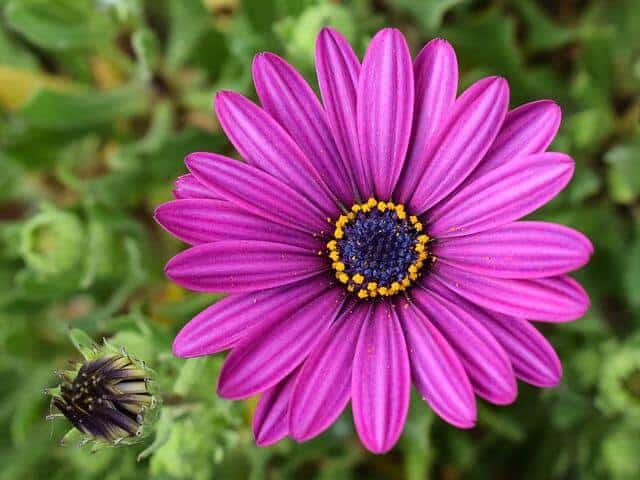
African Daisy, commonly known as Gazania, is a vibrant and cheerful flower that radiates happiness. Its dazzling colors and resilient nature make it a symbol of joy and optimism, even in challenging conditions.
Appearance and Characteristics: African Daisy blooms are a burst of colors, with petals ranging from bright yellow and orange to fiery red and pink. The plant’s ability to thrive in hot and arid climates adds to its appeal, as it reminds us that happiness can flourish even in adversity.
Symbolism: The African Daisy symbolizes happiness, resilience, and the ability to find joy in the most challenging circumstances. Its radiant colors mirror the bright colors of happiness, and its ability to bloom in adverse conditions serves as a reminder that positivity can prevail in the face of difficulties.
Cultural Significance: In various cultures, the African Daisy is considered a symbol of hope and happiness. Its vibrant appearance is often used to uplift spirits and convey well-wishes to friends and loved ones. Giving someone a bouquet of African Daisies is like gifting a burst of radiant happiness.
6. Gentian Violet
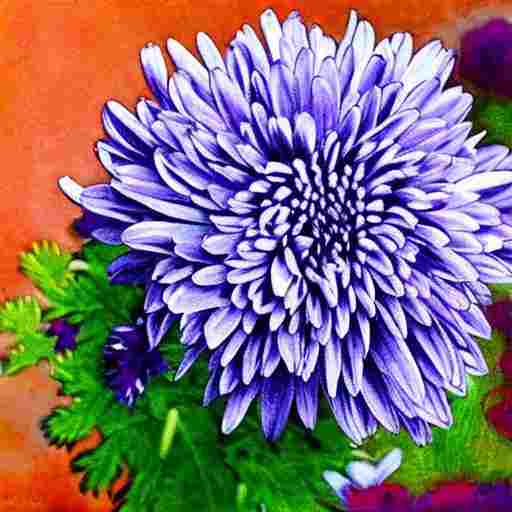
Gentian Violet, known for its striking deep blue or purple blossoms, symbolizes true happiness and a sense of calm. Its serene color palette and soothing presence make it a meaningful flower in conveying feelings of contentment and peace.
Appearance and Characteristics: Gentian Violet is known for its stunningly vibrant blue or purple petals that resemble the calm depths of a clear lake. Its trumpet-shaped flowers add an air of elegance to gardens and floral arrangements.
Symbolism: Gentian Violet is associated with happiness, particularly the serene and profound kind that comes from within. Its deep and tranquil colors represent a sense of inner peace and contentment. Just as the Gentian Violet stands tall and proud, it reminds us to find happiness in our own uniqueness.
Cultural Significance: In traditional herbal medicine, Gentian Violet has been used for its calming properties. It’s believed to soothe the mind and promote a sense of well-being. In the language of flowers, it’s a way to express wishes for happiness and tranquility.
7. Ageratum houstonianum (Floss Flower)
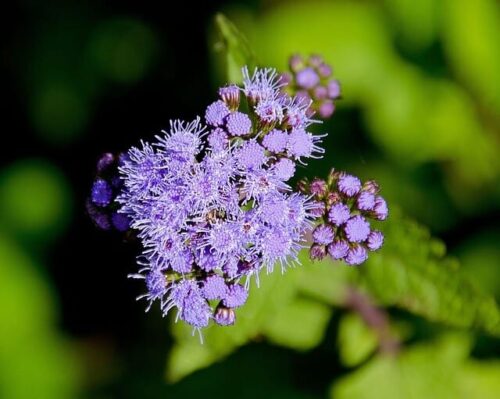
Ageratum houstonianum, commonly known as the Floss Flower, is a delicate and fluffy bloom that symbolizes happiness and carefree joy. Its charming appearance and easygoing nature make it a favorite among gardeners.
Appearance and Characteristics: The Floss Flower features small, tufted clusters of fuzzy blue, purple, or white blossoms. Its soft, almost cloud-like appearance evokes a sense of lightness and playfulness. The plant is known for its profuse flowering throughout the summer months.
Symbolism: Ageratum houstonianum symbolizes happiness in its simplest form. Its fluffy blooms resemble little tufts of joy, and its easy-to-care-for nature reflects the carefree aspect of happiness. Planting Floss Flowers in your garden is like cultivating a patch of happiness that blooms year after year.
Cultural Significance: In some cultures, the Floss Flower is believed to bring good luck and ward off negative energy. Its presence in gardens and floral arrangements is a way to invite happiness and positivity into one’s life.
8. Anemone (Windflower)
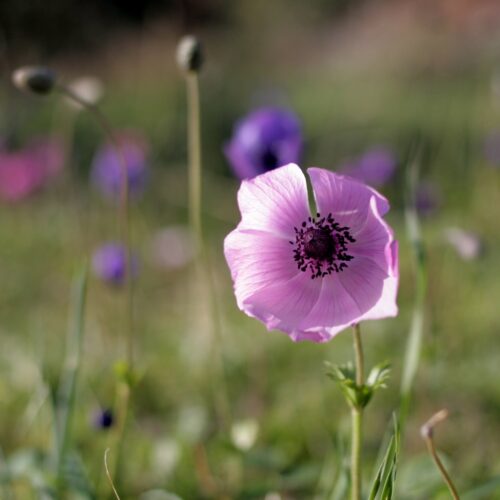
Anemone, also known as the Windflower, is a delicate and graceful bloom that symbolizes happiness and anticipation. Its name itself evokes the image of a gentle breeze, and its petals seem to dance in the wind.
Appearance and Characteristics: Anemone flowers come in various colors, including white, pink, and purple, with a contrasting dark center. Their petals are delicate and almost translucent, giving them an ethereal quality. The plant’s slender stems add to its elegant appearance.
Symbolism: Anemone symbolizes happiness and anticipation, particularly the kind of happiness that comes from looking forward to something special. Its graceful, swaying petals resemble a dance of joy, and its vibrant colors evoke a sense of excitement and positivity.
Cultural Significance: In Greek mythology, the Anemone is associated with the goddess Venus and the story of Adonis. It is said to have sprung from her tears as she mourned Adonis’s death. This connection adds a layer of romantic symbolism to the flower, making it a meaningful gift for expressing love and happiness.
9. Hibiscus
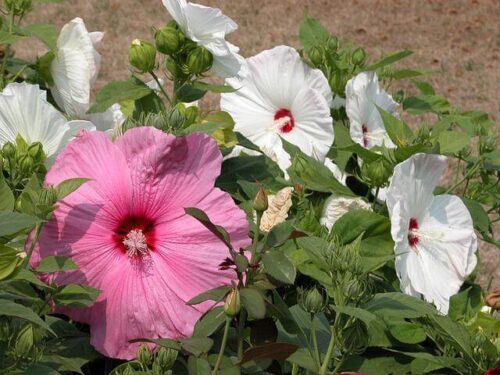
The Hibiscus, also known as the Rose of Sharon, is a flower that exudes happiness and love. Its lush and vibrant blooms have made it a symbol of beauty and positivity in various cultures.
Appearance and Characteristics: Hibiscus flowers are known for their large, showy blossoms with a prominent central stamen. They come in a wide range of colors, including red, pink, white, and yellow. The plant’s glossy, green leaves provide a striking contrast to its vivid flowers.
Symbolism: Hibiscus/Rose of Sharon symbolizes happiness, love, and beauty. Its large and vibrant blooms capture attention and admiration, much like the way love and happiness brighten our lives. In some cultures, it’s also associated with good fortune and prosperity.
Cultural Significance: The Hibiscus is revered in many countries and cultures. In Hawaii, it’s a symbol of hospitality and friendship, often worn as a welcoming gesture. In South Korea, it’s the national flower and represents immortality and love.
10. Anthericum Liliago (St. Bernard’s Lily)
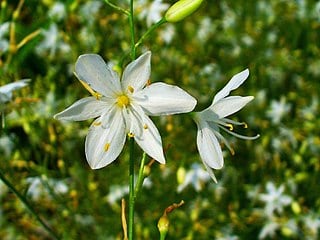
Anthericum Liliago, commonly known as St. Bernard’s Lily, is a graceful and delicate flower that symbolizes happiness and purity. Its pristine white petals evoke feelings of serenity and joy.
Appearance and Characteristics: St. Bernard’s Lily features slender stems adorned with small, star-like white flowers. Its petals are elegant and pristine, creating a sense of purity and simplicity. The plant’s unassuming beauty makes it a charming addition to gardens.
Symbolism: St. Bernard’s Lily symbolizes happiness and purity. Its white petals represent the clarity of happiness and the simple joys of life. Just as the lily stands tall with grace, it reminds us to embrace happiness with dignity and simplicity.
Cultural Significance: In some cultures, the St. Bernard’s Lily is associated with purity and innocence, often used in weddings and religious ceremonies. Its presence symbolizes the hope for a bright and joyful future.
11. Allium roseum (Onion, Garlic)
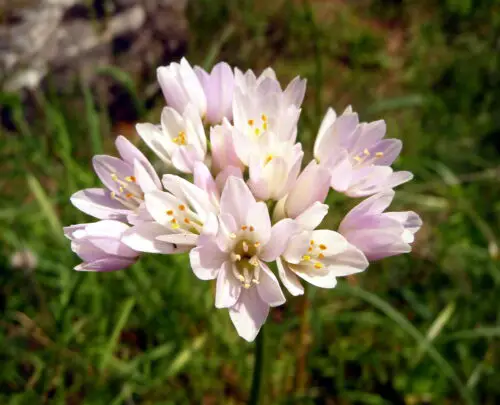
Allium roseum, commonly known as Onion or Garlic, is a unique flower that symbolizes happiness and protection. While its culinary counterparts may be pungent, its delicate blooms are surprisingly charming.
Appearance and Characteristics: Allium roseum produces small clusters of pale pink to lavender-pink flowers. Its delicate petals are adorned with intricate patterns and have a subtle fragrance. The plant’s onion-like leaves add an interesting texture to gardens.
Symbolism: Allium roseum symbolizes happiness and protection, particularly the kind of happiness that comes from unexpected sources. Its unexpected beauty and sweet fragrance remind us to find joy in the unlikeliest of places, just as happiness can surprise us when we least expect it.
Cultural Significance: In some cultures, Allium roseum is believed to protect against negative energy and bring happiness to those who plant it in their gardens. It serves as a reminder that happiness often arises from the simple and unassuming aspects of life.
12. Amaranthus (Prince’s Feather)
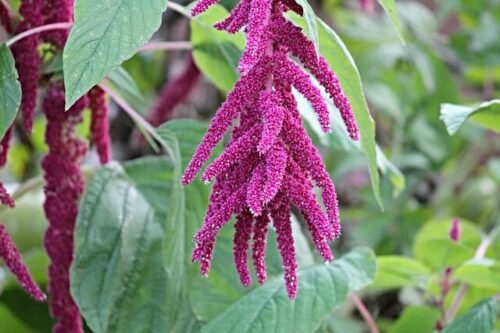
Amaranthus, also known as Prince’s Feather, is a unique and regal flower that symbolizes happiness and immortality. Its striking appearance and rich history make it a meaningful symbol of joy.
Appearance and Characteristics: Amaranthus is characterized by its tall, upright stems and long, cascading tassels of tiny, vibrant red or purple flowers. Its elegant form adds a touch of grandeur to gardens and floral arrangements.
Symbolism: Amaranthus symbolizes happiness and immortality. Its name is derived from the Greek word “amarantos,” which means “unfading” or “immortal.” The flower’s long-lasting beauty and regal appearance reflect the enduring nature of happiness and love.
Cultural Significance: In various cultures, Amaranthus has been associated with rituals and ceremonies. In India, it’s used in religious offerings, symbolizing eternal happiness and devotion. Its use in weddings and festivals further emphasizes its role as a symbol of joy and celebration.
13. Angelonia (Summer Snapdragon)
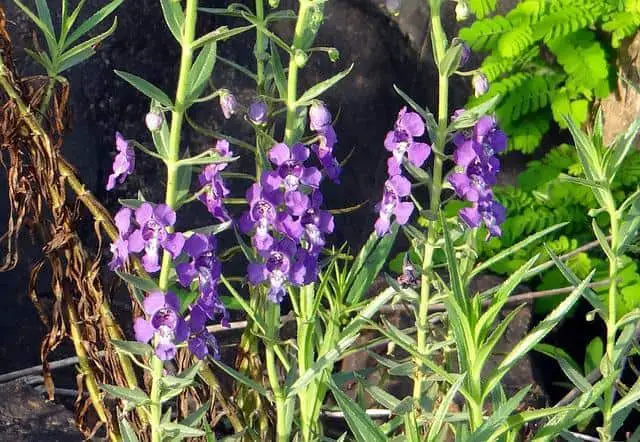
Angelonia, commonly known as the Summer Snapdragon, is a charming and melodious flower that symbolizes happiness and gratitude. Its graceful appearance and sweet fragrance make it a delightful addition to gardens.
Appearance and Characteristics: Angelonia features slender stems adorned with clusters of small, trumpet-shaped flowers in shades of purple, pink, and white. Its delicate blooms resemble miniature snapdragons, creating a whimsical and cheerful atmosphere.
Symbolism: Angelonia symbolizes happiness and gratitude. Its name is derived from the Greek word “angelos,” which means “messenger.” Just as an angelic messenger conveys joyful news, Angelonia’s cheerful blossoms remind us to share and celebrate happiness.
Cultural Significance: In the language of flowers, Angelonia represents gratitude and appreciation. Its presence in gardens and bouquets is a way to express thanks and happiness to those who brighten our lives.
14. Alyssum (Sweet Alyssum)
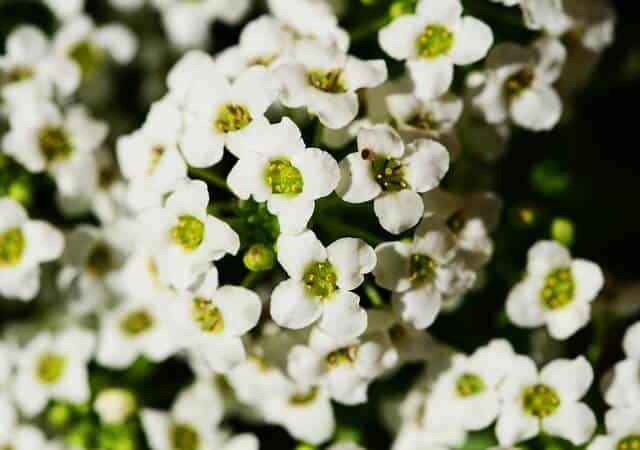
Alyssum, commonly known as Sweet Alyssum, is a charming and fragrant flower that symbolizes happiness and companionship. Its delicate appearance and sweet scent make it a beloved choice for gardens and floral arrangements.
Appearance and Characteristics: Sweet Alyssum features low-growing mounds of small, four-petaled flowers in shades of white, pink, and lavender. Its dainty blooms are known for their sweet fragrance, which adds a delightful element to gardens.
Symbolism: Alyssum symbolizes happiness and companionship.
Dahlias are beloved by gardeners and florists alike for their versatility and timeless beauty. They are often used in floral arrangements to convey feelings of happiness, positivity, and grace. In the language of flowers, Dahlias symbolize inner strength and the ability to find happiness even in challenging times.
21. Bellflower
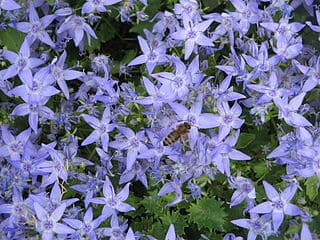
Bellflower, scientifically known as Campanula, is a charming and melodious flower that symbolizes happiness and gratitude. Its bell-shaped blooms and sweet fragrance create a delightful ambiance wherever they are found.
Appearance and Characteristics: Bellflowers come in a variety of species and colors, but they are typically characterized by their bell-shaped, nodding flowers. These flowers can be white, blue, pink, or purple, adding to their enchanting appeal. The plant’s slender stems and delicate leaves enhance its overall grace.
Symbolism: Bellflower symbolizes happiness and gratitude, much like the sweet chime of a bell. Its name, “Campanula,” is derived from the Latin word for “little bell.” Just as the sound of a bell can bring joy and a sense of celebration, Bellflowers remind us to appreciate the beauty and happiness in our lives.
Cultural Significance: In some cultures, Bellflowers have been associated with protection and good fortune. Their presence in gardens and floral arrangements is a way to invite happiness and positivity into one’s surroundings.
22. Agapanthus (Star of Bethlehem)
Agapanthus, commonly known as the Star of Bethlehem, is a graceful and elegant flower that symbolizes happiness and love. Its star-like blooms and serene presence make it a meaningful symbol of joy.
Appearance and Characteristics: Agapanthus features tall, slender stems adorned with clusters of spherical blooms that resemble a burst of stars. These flowers come in various shades of blue and white, creating a serene and captivating visual effect. The plant’s long, strappy leaves add to its overall grace.
Symbolism: Agapanthus symbolizes happiness and love, particularly the kind of happiness that comes from cherished relationships. Its star-like blossoms evoke feelings of joy and celebration, as if each petal were a tiny guiding light leading the way to happiness.
Cultural Significance: In some cultures, Agapanthus is associated with love and affection, often used in weddings and romantic celebrations. Its presence in gardens and landscapes is a way to create a sense of happiness and tranquility in outdoor spaces.
23. Anthurium (Flamingo Flower)
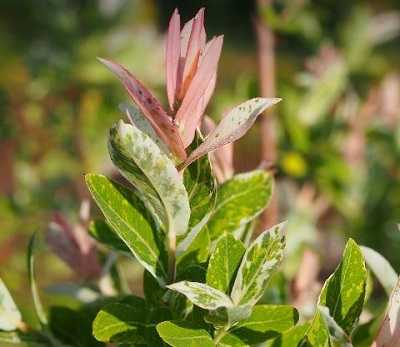
Anthurium, commonly known as the Flamingo Flower, is an exotic and vibrant bloom that symbolizes happiness and hospitality. Its unique appearance and bold colors make it a symbol of joy and enthusiasm.
Appearance and Characteristics: The Flamingo Flower features glossy, heart-shaped leaves and waxy, brightly colored spathes that resemble a flamingo’s beak. These spathes can be red, pink, orange, or white, creating a bold and eye-catching display. The plant’s tropical origin adds to its allure.
Symbolism: Anthurium symbolizes happiness and hospitality. Its exotic and vibrant appearance reflects the idea that happiness can be found in the unique and unexpected. Just as the Flamingo Flower stands out with its bold colors, it reminds us to embrace happiness with enthusiasm and flair.
Cultural Significance: In some cultures, Anthurium is associated with welcoming guests and spreading joy. Its presence in homes and floral arrangements is a way to convey warm wishes and happiness to those who enter.
24. Asclepias syriaca (Purple Milkweed)
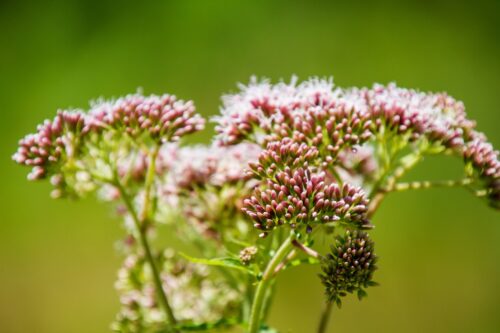
Asclepias syriaca, commonly known as Purple Milkweed, is a nurturing and symbolic flower that represents happiness and transformation. Its role in supporting pollinators and its regal appearance make it a meaningful symbol of positive change.
Appearance and Characteristics: Purple Milkweed features clusters of small, star-shaped flowers in shades of purple and pink. Its unique, umbrella-like blooms are often visited by pollinators, including butterflies. The plant’s robust stems and broad leaves create a stately presence in gardens.
Symbolism: Purple Milkweed symbolizes happiness and transformation. Its role in nourishing pollinators and supporting the life cycle of butterflies reflects the idea that happiness can be found in acts of kindness and positive change. Just as the Purple Milkweed transforms caterpillars into butterflies, it reminds us of our capacity for growth and renewal.
Cultural Significance: In some cultures, Purple Milkweed is associated with healing and transformation. Its presence in gardens and landscapes is a way to invite positivity and change into one’s surroundings.
25. Antirrhinum majus (Snapdragon Flower)
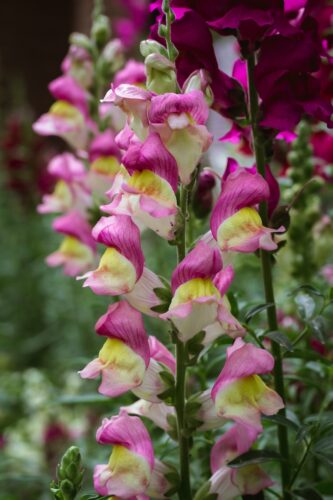
Antirrhinum majus, commonly known as the Snapdragon Flower, is a charming and whimsical bloom that symbolizes happiness and hope. Its unique structure and the way its petals open and close evoke feelings of joy and positivity.
Appearance and Characteristics: Snapdragon flowers are known for their distinctive shape, resembling a dragon’s head that can be opened and closed when gently squeezed. They come in a variety of colors, including red, pink, yellow, and orange. The plant’s tall, spiky spikes of blossoms add a playful touch to gardens.
Symbolism: Snapdragon Flower symbolizes happiness and hope, particularly the kind of happiness that comes from embracing life’s playful moments. Its whimsical appearance and the way its petals can be manipulated evoke feelings of joy and positivity.
Cultural Significance: In the language of flowers, Snapdragon is associated with sentiments of happiness and grace. Its presence in bouquets and gardens is a way to convey wishes for joy and optimism.
26. Alstroemeria (Peruvian Lily)
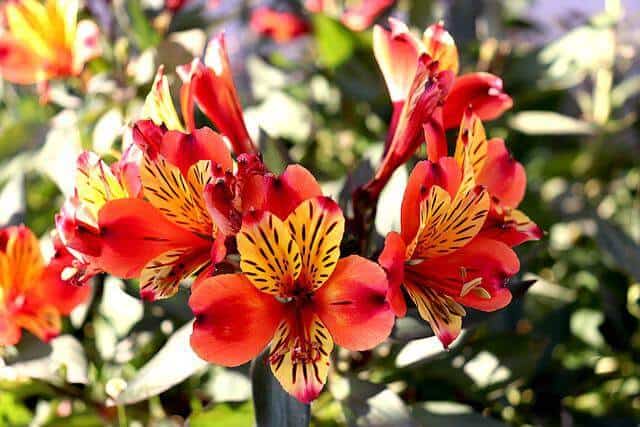
Alstroemeria, commonly known as the Peruvian Lily, is a graceful and vibrant flower that symbolizes happiness and friendship. Its intricate blooms and radiant colors make it a symbol of joy and camaraderie.
Appearance and Characteristics: Peruvian Lily blooms feature multiple petals with unique patterns and markings, creating a visually striking display. These flowers come in various shades, including orange, pink, yellow, and red. The plant’s slender stems and glossy leaves add to its overall elegance.
Symbolism: Alstroemeria symbolizes happiness and friendship. Its intricate and vibrant blooms reflect the idea that true happiness is often found in the company of good friends. Just as the Peruvian Lily’s flowers cluster together, it reminds us of the warmth and joy of camaraderie.
Cultural Significance: In some cultures, Alstroemeria is associated with lasting friendship and mutual support. Its presence in bouquets and floral arrangements is a way to convey sentiments of happiness and appreciation to friends and loved ones.
27. Fairy Iris

Fairy Iris, scientifically known as Dietes, is a charming and whimsical flower that symbolizes happiness and enchantment. Its graceful appearance and delicate blooms evoke feelings of joy and wonder.
Appearance and Characteristics: Fairy Iris features slender stems and elegant, iris-like blooms in shades of white and yellow. Its petals have a delicate and airy quality, creating a sense of enchantment and grace. The plant’s slender leaves add to its overall charm.
Symbolism: Fairy Iris symbolizes happiness and enchantment, particularly the kind of happiness that comes from embracing life’s whimsical moments. Its delicate and ethereal appearance evokes feelings of joy and wonder, as if each bloom were a fairy dancing in the garden.
Cultural Significance: In some cultures, Fairy Iris is associated with magic and transformation. Its presence in gardens and landscapes is a way to invite positivity and a sense of wonder into outdoor spaces.
28. Columbine
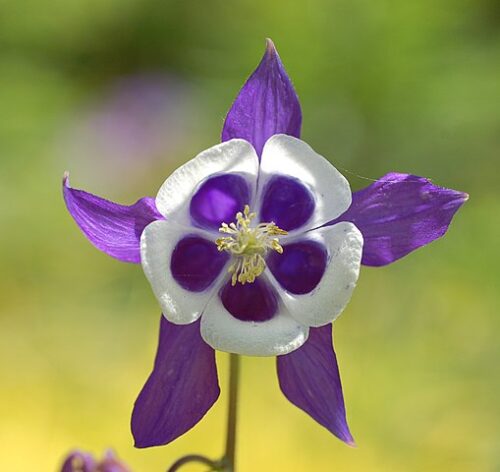
Columbine, scientifically known as Aquilegia, is a charming and melodious flower that symbolizes happiness and affection. Its graceful appearance and vibrant colors make it a favorite among gardeners.
Appearance and Characteristics: Columbine features delicate, bell-shaped flowers with a distinctive spur at the back. These flowers come in a variety of colors, including white, pink, and purple, with a contrasting dark center. The plant’s slender stems add to its elegant appearance.
Symbolism: Columbine symbolizes happiness and affection, particularly the kind of happiness that comes from cherished relationships. Its unique and intricate flowers resemble a joyful dance, and its vibrant colors convey feelings of love and admiration.
Cultural Significance: In some cultures, Columbine is associated with love and fidelity. Its presence in gardens and floral arrangements is a way to express love and happiness to those who hold a special place in our hearts.
29. Aconitum (Ranunculus Family)
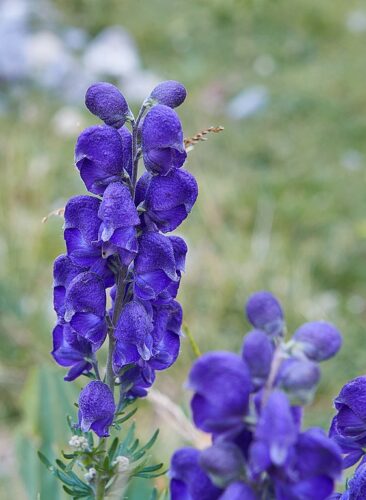
Aconitum, a member of the Ranunculus family, is a unique and symbolic flower that represents happiness and positive transformation. Its distinctive appearance and historical significance make it a meaningful symbol of joy.
Appearance and Characteristics: Aconitum flowers feature tall spikes of hooded, helmet-like blossoms that come in shades of blue, purple, and white. The plant’s unusual shape and vibrant colors create a striking visual display. The plant’s robust growth habit adds to its overall presence.
Symbolism: Aconitum symbolizes happiness and positive transformation. Its unique and distinctive appearance reflects the idea that happiness can be found in embracing our individuality and uniqueness. Just as Aconitum stands tall and proud, it reminds us to celebrate our own essence of happiness.
Cultural Significance: In various cultures, Aconitum has been used for its medicinal properties and as a symbol of protection and transformation. Its presence in gardens and landscapes is a way to invite positivity and personal growth into one’s surroundings.
30. Astilbe (False Goat’s Beard, False Spirea)
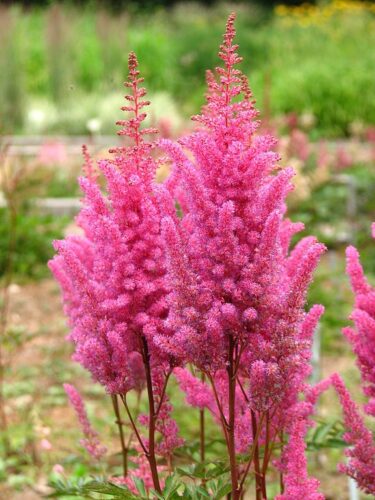
Astilbe, commonly known as False Goat’s Beard or False Spirea, is a graceful and elegant flower that symbolizes happiness and patience. Its feathery plumes and serene presence make it a meaningful symbol of positivity and endurance.
Appearance and Characteristics: Astilbe blooms feature feathery plumes of tiny flowers in shades of pink, red, white, and lavender. These plumes create a soft and elegant display, resembling a cascade of delicate feathers. The plant’s fern-like foliage adds to its overall grace.
Symbolism: Astilbe symbolizes happiness and patience. Its feathery plumes evoke feelings of joy and celebration, and its serene appearance reflects the idea that happiness can be found in moments of tranquility. Just as Astilbe’s blooms gently sway in the breeze, it reminds us to embrace happiness with grace and endurance.
Cultural Significance: In some cultures, Astilbe is associated with love and dedication, often used in wedding bouquets and arrangements. Its presence in gardens and floral displays is a way to convey sentiments of happiness and everlasting love.
In conclusion, these 30 flowers, each unique in its appearance and symbolism, collectively form a vibrant bouquet of happiness and love. Just as a bouquet combines various blooms to create a beautiful arrangement, life’s happiness is composed of diverse moments and relationships. Whether you find joy in the simplicity of a Lady’s Mantle or the vibrant burst of color from an African Daisy, these flowers remind us that happiness can be found in the everyday, in love, in friendships, and in the beauty of the world around us. As we journey through life, may we continue to cultivate our own gardens of happiness, nurturing positivity, and sharing the love symbolized by these beautiful blooms.
